Programming is one of the most popular professions in the world today, with the number of developers expected to reach 45 million by 2030. It’s no surprise as to why either. With the influx of technology, everyone aspires to become a full-stack developer at a Silicon Valley company or create the next groundbreaking platform for emerging tech like the Metaverse.
For most, it seems, website and software development is the ideal job of the future with plenty of opportunities in Machine Learning and Cyber Security still to come. But with the industry brimmed full of developers of all types and experiences, selecting a handful to entrust your new big project can seem daunting and may even be potentially risky.
This conundrum is especially pertinent to people looking to develop websites and web applications that inherently require great attention to detail from start to finish. Hiring the right full-stack developer isn’t the easiest option for most.
Fortunately, our guide can help you get started on the hiring process. By the end of this article, you’ll be clear about all key aspects of full-stack developers and their related skills that you should be looking for in your next recruit.
What Is A Full-Stack Developer?

Web and application development are typically done in two separate sections - server-side and client-side. These two are also commonly referred to as back-end and front-end development respectively. Then there is a third type which is called full-stack development. Let’s understand the basics of these three developer types.
I. Front-End Developer
Client-side or front-end development refers to the development of a program that functions on the user’s side. Front-end developers create the part of the software with which the user can interact. These developers have the following responsibilities:
- Reviewing the performance of the product
- Building the website or app’s user interface or design layout
- Resolving user issues that may occur when the software is in use
- Adding visual elements to the design such as animation, texts, shadows, and fonts
II. Backend Developer
Server-side or backend development refers to the development of a program that functions on the server. All front-end development efforts are in vain if the back-end isn’t fully developed. Its importance stems from the fact that websites and apps connect to cloud-based or remote servers to fetch information for the user.
These developers have the following responsibilities:
- Connecting products to databases and servers
- Managing the safety and security of the product
- Integrating CMS (Content Management Systems
- Developing web apps and programming dynamic websites
III. Full-Stack Developer
The third type and the subject of our discussion is full-stack development, which takes both, client-side and server-side development and combines them under one job role.
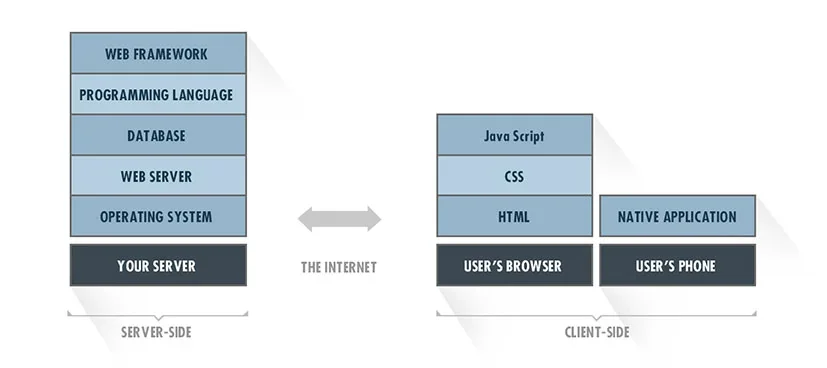
Full-stack technology is the entire depth of software development and developers in this trade juggle front-end and back-end development. The term “full-stack developer” originated in the early days of the internet when websites were small-scale developments and only required a single developer to manage the front and back end.
Today, businesses either employ separate teams of front-end and back-end developers or a few full-stack developers to get the job done. Tasks are then distributed and divided based on the development methodology implemented by the teams.
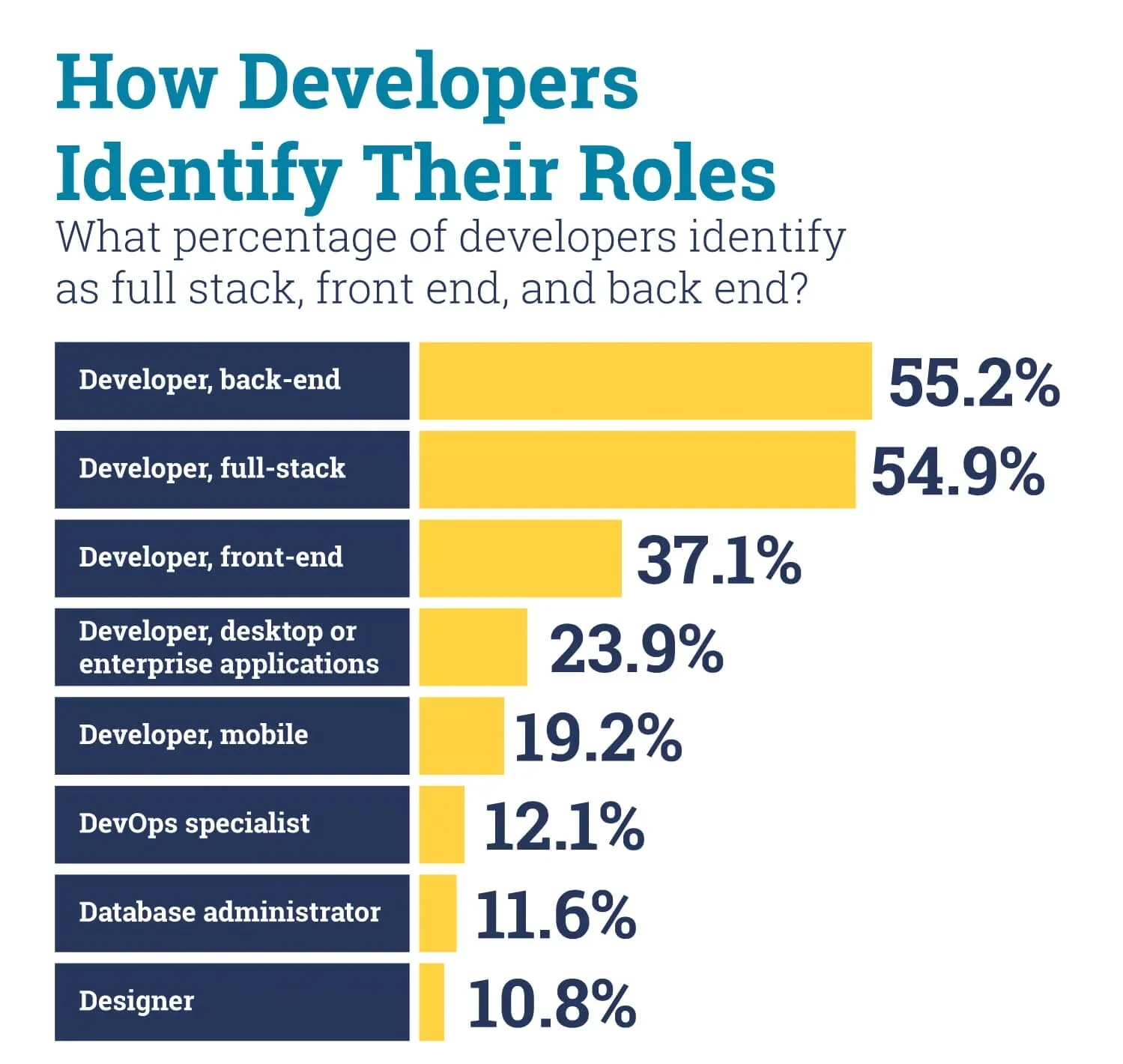
According to this 2020 survey, almost 55% of website developers self-identified as full-stack developers. And it makes sense why full-stack development is reigning supreme in the industry. Developers typically get paid more if they exhibit skills for both ends of development, and companies are shifting from the older divided model to full-stack.
Responsibilities Of A Full-Stack Developer
We’ve established the popularity and appeal of full-stack development for programmers and companies alike. Understanding the developer’s job responsibilities is also an important element before you go hiring your team of full-stack web developers.
Some of the responsibilities include:
1. Developing Front-End Website Architecture
The primary goal of any website or application is to ensure that it is easy to use and comprehensible to the user. But this goal isn’t always easy to achieve, especially with the plethora of devices available to users today.
Adjusting for screen sizes and resolutions is a difficult task that front-end developers need to take into account. They need to ensure that the website is functional cross-platform, cross-browser, and cross-device.
2. Designing User Interactions
User interface architecture is the first aspect of website development. Understanding the basics of user experience is also vital for developers to consider. A carefully thought-out design serves very little purpose if the user has trouble navigating through the site or application.
Full-stack developers, therefore, are experts in UI and UX design and ensure that the product is easy to understand, has the simplest learning curve for newer users, and scores great in usability metrics.
3. Developing Back-End Apps
As we discussed earlier, full-stack developers emphasize both sides of web development. Once the front end is designed, developers shift their attention to the server side and begin implementing apps and CMS in the backend. This implementation is usually powered by Python, NodeJS, and PHP.
4. Building Databases And Servers For Functionality
The web server requires a database server to store data and this part of the job ensures all information is inputted correctly for the server to work. MongoDB and MySQL are powerful languages used to develop database servers.
5. Organization For Cross-Platform And Mobile Platforms
The requirements for platforms and mobile devices are vastly different and are accounted for during the organization phase. Developers use Linux, Windows, and Mac machines and with plenty of browser options available, it is vital to optimize and ensure that the website displays and works correctly. Mobile devices are similar where screen sizes and compatibility matter most.
6. Collaborating With Web Designers
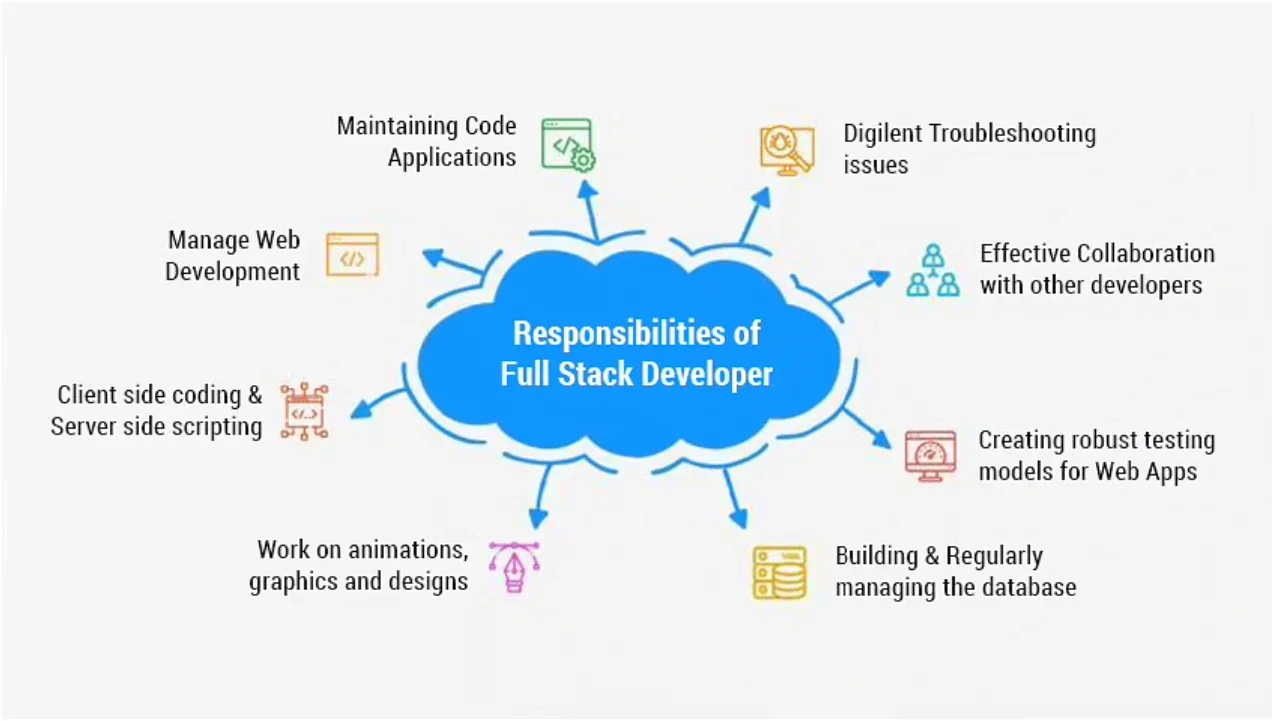
While full-stack development entails that developers are familiar with UX/UI, the job is largely handled by dedicated web designers. Full-stack developers work alongside the designers to ensure all design and layout cues are followed and implemented. Developers then use languages such as HTML, CSS, and Python to bring the design elements to life.
7. Overseeing The Project Until The End
Great full-stack developers aren’t just coders and programmers, but they perform double duty as diligent project managers too. They guarantee the successful completion of all software projects as well as their timely delivery and support afterward.
Our team of meticulously hired developers knows this all too well. We ensure that our talented coders oversee all aspects of the project from start to finish. And with the most talented full-stack developers selected from all over the world, you can rest assured that Aloa has all eyes and hands on deck when it comes to developing your project to completion.
8. API Design And Development
Good API design consists of a solid structure and documentation of resources. APIs inform user experience and are essentially how the software communicates with the server. Full-stack developers ensure they pick the right stack for this purpose. React is a popular API for web and custom mobile app development.
9. Staying Updated On Web App And Language Developments
Any skilled professional that shies away from continued progress and learning is naturally left behind as the world moves on. It is a harsh reality in the world of development too. Languages go out of favor, frameworks become obsolete, and new technologies continue to be developed.
Full-stack developers need to remain updated with the latest in the field and continue to develop their skills and trade. Familiarizing themselves with new environments is part of the hustle.
9 Skills A Proficient Full Stack Developer Should Possess
Full-stack development requires a certain skill set that helps them excel at their position. If you’re looking to hire a full-stack developer for your project, keeping an eye out for these skills is non-negotiable.
Skill #1: HTML/CSS Development
HTML is the default structuring language for websites and CSS lets you style and customize it. A developer needs to excel at these to develop efficiently and attract prospective customers with an engaging and intuitive design.
The two programming languages work in tandem and necessitate the use of the other. Without HTML, websites and web apps don’t have a structure to follow and without CSS, the structure can be bland and plain.
Skill #2: JavaScript
JavaScript is a mandatory skill to learn for any full-stack developer. Developers use JavaScript to write code for front-end and back-end functionalities, and its versatility works in a browser or server (NodeJS) making it an essential language to have in your development team.
Great full-stack web development will almost always require JavaScript and any accompanied frameworks or libraries that modernize its use.
Skill #3: GitHub
GitHub is a popular open-source platform for developers that can handle small and large-scale development requirements. It enables them to manage any changes to their code, apps, websites, and any other information associated with their project.
Git is a version control tool used for tracking small and large modifications to the project and to access it, developers need a GitHub account. Having this skill can enable your developers to collaborate better with other developers working on similar projects.
Skill #4: PHP, Python, Ruby, And Java
PHP, Python, Ruby, and Java are backend languages that are essential if you require a full-stack developer to handle your project’s back-end as well.
PHP can work on all major operating systems, Python has rich libraries and is easy to learn, Ruby is a powerful development language, and Java is one of the most popular development tools for front and back-end coding.
Skill #5: REST And HTTP
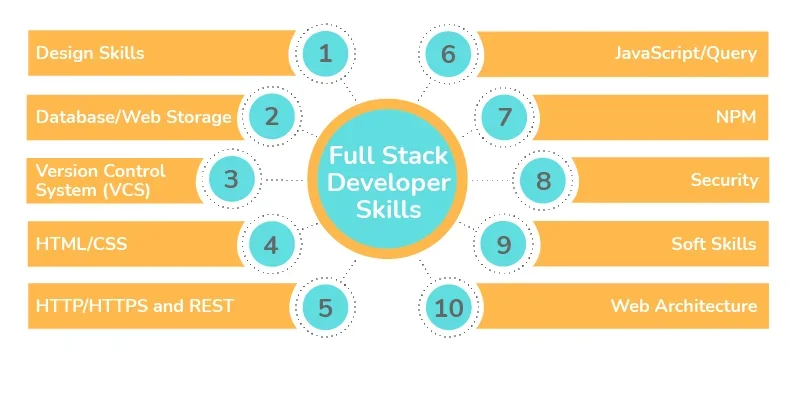
Full-stack developers use HTTP to facilitate communication with the client and REST as an interface between systems that use the HTTP protocol. HTTP gathers the information for the client, whereas REST acts as the translator for the back and front end. Mastering both is essential for all full-stack developers.
Skill #6: Database Storage
No website or application works without a database to store all the data that it’ll require during operation. A great full-stack developer knows relational database and database storage better than most and should have the data analytics skills to design, change, and understand database queries.
Full-stack developers should also be familiar with SQL, XML, and JSON and know about NoSQL databases.
Skill #7: Web Design Skills
We mentioned earlier how companies typically employ teams of designers for their products but a full-stack developer should know the basics too since they’ll be spending a considerable amount of time turning wireframes and Photoshop files into working models.
Even if you have developers that aren’t proficient web page designers, you should ensure that they have the basics down at least and know how to work their way around textures, borders, shadows, and other visual cues.
Skill #8: Creativity
All professionals in the software development industry benefit from creativity. While most businesses perceive full-stack web developers as dull professionals with single-minded approaches, the truth couldn’t be farther from it. In reality, developers are incredibly creative and happen to be quick learners, thanks to their intuitive problem-solving skills.
But this developer skill should also be demanded during the development phase when a project requires work from scratch and finding solutions to complex problems is the biggest hurdle for your teams.
Skill #9: Ability To Work In A Team
Developers typically work in isolation and focus on their side of the project with little to no collaboration with other members and even developers. This trend may have passed a few years ago, but with companies emphasizing more collaborative environments and methodologies practically demanding everyone to work together, developers need to be great team players.
Aloa understands better than most that finding full-stack developers with all the skills listed here is a very difficult task. Most developers ticking all those boxes are already snatched up by the best businesses. Here’s where Aloa can help.
We keep a pool of full-stack developers that are ready to work full-time or part-time on your next project. And with our constant skill upgradation boot camps and assessments, you know you’re getting the best professionals available for your development requirements.
5 Reasons Why Businesses Need Full-Stack Developers
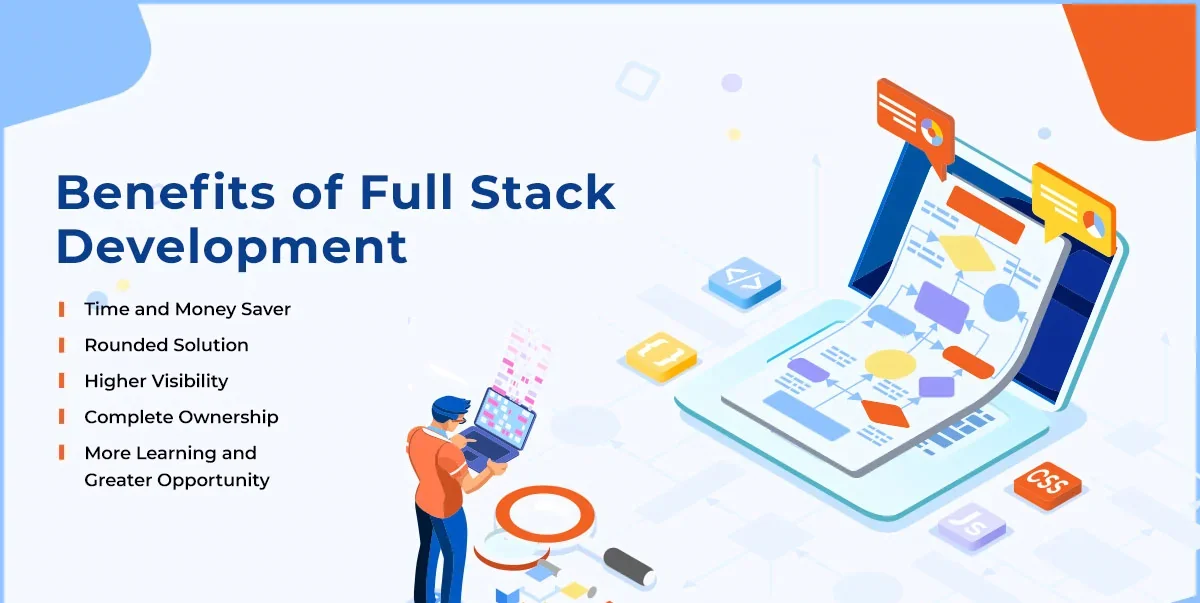
Full-stack developers have the technical know-how to be some of the most in-demand software engineers in the job market. But businesses still may be tempted to hire front-end and back-end developers and build a team with them. However, they’ll be missing out on a few great benefits if they do.
Full-stack developers can potentially provide your business with:
Reason #1: Cost And Time Effective Solutions
Without the need for separate departments or teams for front-end and back-end developments, you can save time by combining the two under the same group and executing tasks more efficiently. This way, you can ensure that the project delivery schedule remains on point.
And let's not forget how much money this would save a company too. Front-end and back-end software engineers need to be hired by the handful which can quickly become an expensive outlay if the budget doesn’t allow for it. Keep your teams small and focused.
Reason #2: Efficient Workflows
A developer that has the full scale of development knowledge and expertise can help you build better and more efficient products without as many bugs or flaws. Having the code run and tested by one individual that has coded the front and back end can make debugging easier as well.
Companies can then ensure that the time to complete and deliver a project is much quicker than it would’ve been with separate teams working on the same software.
Reason #3: Greater Visibility
Full-stack developers are excellent resources to help plan the software project thoroughly and extensively. They can map out the entire lifecycle accurately and design structures while keeping solutions in mind.
These full-stack engineers have a multi-faceted way of approaching problems and can help build websites and apps with solutions that fit both ends of the development perfectly.
Reason #4: Total Ownership
Most quality assurance and code debugging professionals know this point all too well. The constant back and forth between front-end and back-end teams can become infuriating when a massive development bug surfaces.
This situation can be easily avoided with full-stack teams since each professional is tasked with their segment of the development and debugging. No more hurling blames (and insults) at other groups for their mistakes. It also means developers can quickly address issues too without wasting additional time and resources.
Reason #5: Increased Learning
Full-stack developers get more opportunities to learn and further their careers. This creates better opportunities at their existing companies where the developers can excel at different aspects of development.
Some of them may become solution-oriented and can help you plan and execute projects by building functional and architectural blueprints for the teams to follow. They also get to flex their muscles on both ends of the development spectrum.
This continuous cycle of learning rewards them with greater skills and the companies with much more rounded professionals on the team.
Conclusion
Full-stack development is the future moving forward and with the majority of web developers already identifying themselves in this category, the shift has begun. We’ll see a trend where back-end developers start picking up front-end skills and vice versa.
The benefits are plenty as well, both to developers and companies that employ them. But if you can’t wait for the future to find dedicated or remote development resources, Aloa has you covered.
You can sign up and hire full-stack developers for all your software and website building requirements. We have a vast list of the best and most specialized professionals that have years of experience and can get started today.
We are always reachable and approachable with just a mail away. Contact us at [email protected] for further queries or find out more about our services by visiting the Aloa website.

![What Is A Full Stack Developer? [Skills & Role]](https://images.aloa.co/posts/full-stack-developer/63861d292774f6a8a71c7305_b7.webp)